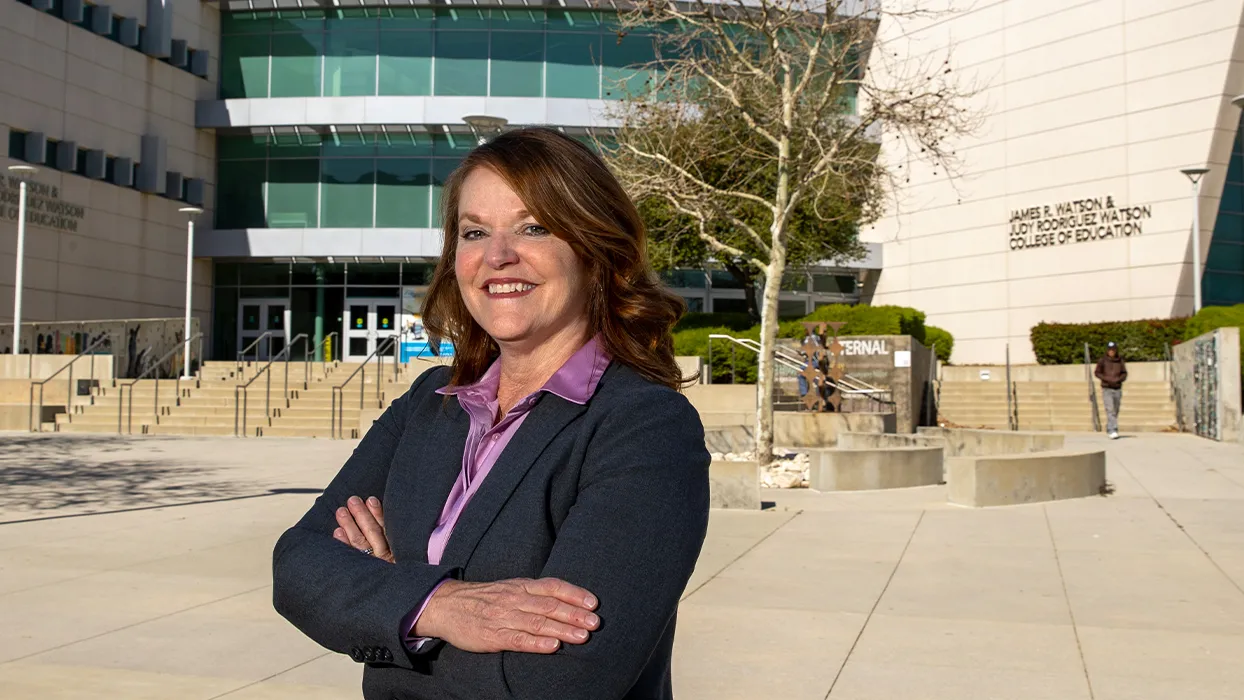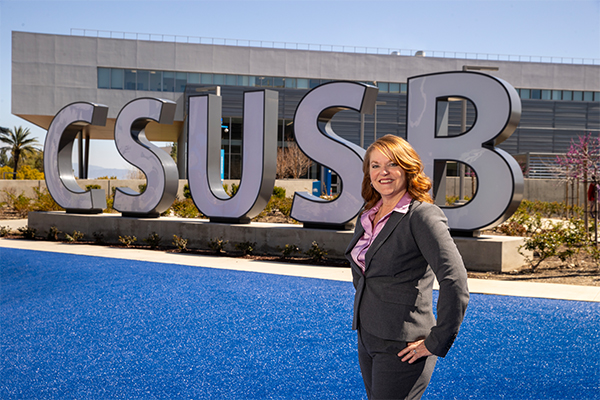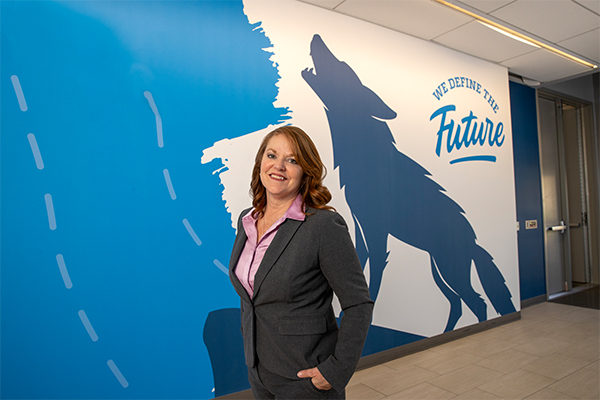Alan Llavore | Office of Marketing and Communications | (909) 537-5007 | allavore@csusb.edu

Growing up in Hesperia, Michelle Smith (formerly Michelle Powell, Michelle Estrada) never imagined where her educational and career path would take her. A product of the Hesperia public school system, she attended Joshua Circle Elementary, Juniper Elementary, Hesperia Junior High and graduated from Hesperia High School. As an adult, she began working within the Hesperia Unified School District and now, 31 years later, she is poised to become the district’s superintendent on July 1. She will succeed Superintendent David Olney, who is retiring on June 30.
When Smith began her college journey, she intended to go into business or law. She initially enrolled at Victor Valley College and discovered she had an interest in teaching.
“Teaching happened as I was taking math classes, taking calculus, being kind of that classroom tutor, having study sessions with people and helping,” she said. “So much joy came from helping people access that information.”
Smith transferred to Cal State San Bernardino and completed her bachelor of arts in math. But she had to figure out the higher education pathway that took her there by herself.
“I come from a large family: I was the second of seven children,” she said. “When you are the first in your family to attend college, you don’t know the system. I didn’t apply for any financial aid. I was married with children — I didn’t even know to apply.”
Ever resourceful, though, she asked questions and discovered the Intersegmental General Education Transfer Curriculum, or IGETC, when she was at Victor Valley. “It gave me my rules and a task list to follow. And then I was able to transfer,” she said.

Smith remembers the great value of faculty support. “Dr. Zahid Hasan was one of the most amazing professors I had in the CSUSB math department,” she said. “During my very last term, he said to me, ‘Michelle, I want to put your name forward for a fellowship to earn a master’s degree in math.’ But, at that time, I couldn’t afford not to go directly into the workforce.” Nevertheless, this encouragement carried with it a great deal of power. “Dr. Hasan was saying, ‘You are capable.’”
She started as a math teacher at Hesperia High School (her alma mater) in 1994, followed by a short stint as a cheerleading coach and taught in a special education classroom on an emergency credential, and then returned to teaching math. “Teaching was my first formal job ever,” she said. “I was learning all I could from everyone — I was learning like a sponge.”
While teaching, she heard that CSUSB was offering a master of arts in educational administration degree in satellite districts. It was affordable and allowed her to continue working and be with her growing family of small children as she studied. The program included requirements for shadowing an administrator, and she found herself applying for an administration opening at Hesperia Junior High. To her surprise, she was hired.
After several years as a co-administrator, she was hired as the principal at Cedar Middle School. She spent a year after that in the district office. And then her dream job opened up: principal at Hesperia High. She applied.
“It was very cathartic to be hired in that role,” she said. “I had applied years before but had not been selected. It was very cathartic to be told ‘yes’ this time.”
Her next career step was to become director of secondary education at Hesperia USD, followed by the position of assistant superintendent of educational services.
“In that first role, I covered three alternative schools, three middle schools and three high schools. You finally get to see the system from a different lens: the interplay between different schools and different initiatives. From that perspective, you begin building out pieces that allow you to recognize the gaps you need to fill. It was a wonderful, wonderful experience.”
She added that the pandemic occurred during her time in that role. “It was a trying time in education, but also a rewarding time because you come together and re-focus.” She paused as she remembered and added that it was “the way we were able to hold each other up at a difficult time” that sticks with her.
In her current assistant superintendent role, she has been responsible for secondary and elementary education, special programs, special services, college and career readiness and Career and Technical Education, or CTE, pathways.
“I have a phenomenal team,” she said. “They are the kinds of leaders you want to have leading our programs and leading our students: people who roll their sleeves up and get things done.”
It was during her time as a school site administrator that she decided to return to CSUSB to obtain her doctorate in educational leadership, or Ed.D. While her master’s degree was helpful for advancing her career, “the Ed.D. was for me.” She found the doctoral program to be transformative.
“The MA was about learning the systems, the rules, the laws. The Ed.D. was about the why, about the deeper purpose,” she said.
Donna Schnorr, professor emeritus, and Doris Wilson, former associate dean of the CSUSB Palm Desert Campus, served as her lifelines through her doctoral studies. She called them “two parts of a whole.” She explained how both worked in complementary ways to support her. They were the ones who encouraged her to persist through graduation.
“Dr. Schnorr helped me to see that my work, my perspective, was already different because of what I had learned in the doctorate, but I needed to actually finish my dissertation and get that title,” she said.
Wilson came from being a superintendent herself and gave her the other side of the equation. Wilson’s class assignment of students doing a strategic plan on themselves impacted her profoundly. “Once you do an exercise like that, connect more deeply to yourself and your truth, then you can be effective in the school system as an administrator,” she said.

Smith truly knows the students in her district from having grown up in it. “Our students have big, beautiful brains. They have all the capability of students from high performing districts.” She sees her goal as an educator in Hesperia USD is to ensure “that our outcomes match the outcomes of more affluent areas — affluence should not dictate opportunities.”
For her, that begins with addressing the barriers Hesperia students face because these students do not lack ability. She looks at questions of poverty, access to health care, long commuting times for working parents and affordable housing.
“I have been the busy parent — it’s not easy,” she said. “There are so many pressures on our families now: cost of living, negative influence of social media on our teenagers. So, how can we support and wrap around the whole community?”
Smith sees education as the path forward for bettering the lives of the district’s students and the community as a whole. She wants to ensure that “each and every student graduates from our system with all of the doors open. We have to see they’ve met all the requirements — for a career, military training, tech college, community college, a CSU — so our students can have the paths wide open for them.”
Smith looks forward to deepening the connections between Hesperia USD and CSUSB.
“So many things are more powerful if you backward map them.” She explained this to mean looking at opportunities at CSUSB and how they might connect to the district. For example, the university’s cybersecurity pathway might connect with the ICT pathway at one of her district’s schools. “So, how can we connect these two in a more explicit way — through a dual pathway program, for example?”
She underscored the importance of creating an on-ramp for students to go from high school to college. “Make explicit connections — what are the programs that CSUSB has to offer which are of benefit? Then we need to ask, ‘How can we change our system at Hesperia USD and re-think some of our career pathways so that they connect?’”
She concluded, “Once you connect, you create that on-ramp. If students have to make the leap from one to the other, that is much harder. Establishing those on-ramps makes a difference.”
Her primary piece of career advice, however, is on how to be a whole human being in the world. “We should never be completely defined by our career,” she said. “That inner work means that we have other components. Maintaining our personal health, physical health, spiritual health, emotional health, etc.”
She added, “I didn’t have a traditional trajectory. For example, my path through college was immediate, but not quick.” But, despite that unconventional pathway, she has built a successful career. And, on top of it all? “Honestly, I have never had a job I didn’t like.”
She is thankful for her own healthy personal life: four wonderful adult children, a husband she describes as her best friend, and making sure she stays deeply connected to her inner self beyond the role she serves at Hesperia Unified.
“You are not just one thing; you are so many things,” she said.
Smith is grateful to be serving her hometown through her career at Hesperia USD, which includes her colleagues, the district’s students and the leadership provided by retiring Superintendent Olney. As for what comes next after July 1? “I am excited about the networking across our region, excited about our connected tissue, and tightening and strengthening that connected tissue.”
CSUSB president Tomás D. Morales frequently speaks about community engagement and giving back as being key parts of the DNA of CSUSB students and graduates. Michelle Smith’s life provides an amazing example of that Coyote DNA in action throughout her career. It may have been three decades so far at Hesperia, but she is just getting started.